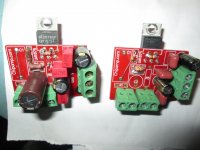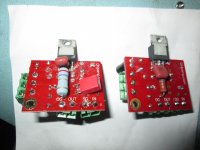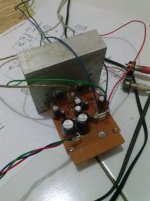^ actually that's common knowledge
Source please?
That's the polite way of asking.Source please?
I am afraid to admit, I would be less diplomatic.
I'll guess this phenomena is not so important here. frank, if the transistor works near it's Vce max then the distortion will increase and this is noticable in a VAS stage in particular when you have large voltage swings.
The LM3886 is a newer design so I'll guess it's improved compared to the LM3875
The LM3886 is a newer design so I'll guess it's improved compared to the LM3875
HELLO?That's the polite way of asking.
I am afraid to admit, I would be less diplomatic.
BANDWIDTH? BGP?
Have we all forgotten everything about transistors?
Let's forget about facts and science for a moment since that seems fleeting, and just do the old school, try-it-and-decide-for-yourself-test.
For a different approach, meaningful data might include head to head measurements of real life running samples, tested at the same location, with the same equipment, on the same day and with the same methods. Otherwise, bunk.
If you want to prove speed, it could be possible to rig them both as RF amplifiers and see which one hoots to the highest frequency while also amping a reasonable quality signal. The fastest one will operate at the highest frequency with the signal still useful.
As far as operational speed as an audio amplifier, both amplifiers top out at gain 45 (48 is much poorer quality signal) when run on typical voltages, which are different. If, both amplifiers are run at the same voltage as typical for LM1875, one of them is considerably more useful for music playback. Since in this comparison, LM1875 operated further above potential and more efficiently, it would win this useless contest that didn't employ LM3886 typically. In fact, the spike system blocked validity of this, and most, comparisons. Removing that noise to achieve a hi-fi class amplifier requires Howland Current Pump (myref) or Nesting/Composite or the spurious noise cancellations of Parallel Amplifier (PA150). This is merely a financial matter. LM1875 does hi-fi cheaper and easier due to a major difference in ideal support circuit. This thread is almost like an earlier thread that talked about the quality of small op-amps with no mention of optimized support circuits for them. That still doesn't work.
If you want to prove speed, it could be possible to rig them both as RF amplifiers and see which one hoots to the highest frequency while also amping a reasonable quality signal. The fastest one will operate at the highest frequency with the signal still useful.
As far as operational speed as an audio amplifier, both amplifiers top out at gain 45 (48 is much poorer quality signal) when run on typical voltages, which are different. If, both amplifiers are run at the same voltage as typical for LM1875, one of them is considerably more useful for music playback. Since in this comparison, LM1875 operated further above potential and more efficiently, it would win this useless contest that didn't employ LM3886 typically. In fact, the spike system blocked validity of this, and most, comparisons. Removing that noise to achieve a hi-fi class amplifier requires Howland Current Pump (myref) or Nesting/Composite or the spurious noise cancellations of Parallel Amplifier (PA150). This is merely a financial matter. LM1875 does hi-fi cheaper and easier due to a major difference in ideal support circuit. This thread is almost like an earlier thread that talked about the quality of small op-amps with no mention of optimized support circuits for them. That still doesn't work.
^ While I agree to some extent about "signal still useful", that isn't quite the whole story.
You can have a bandwidth above what is required for a signal, that (just barely) gets sufficient levels in the right time span to discriminate them digitally (or audibly) but the resolution is still poor. Rather than just falling withing the time window of a certain frequency, it still matters how close the response comes to the target.
For example, we'd never even consider a (hypothetical) transistor with a bandwidth of only 20KHz to reproduce a 20KHz signal.
You can have a bandwidth above what is required for a signal, that (just barely) gets sufficient levels in the right time span to discriminate them digitally (or audibly) but the resolution is still poor. Rather than just falling withing the time window of a certain frequency, it still matters how close the response comes to the target.
For example, we'd never even consider a (hypothetical) transistor with a bandwidth of only 20KHz to reproduce a 20KHz signal.
Okay, your scenario is possible, but we'll have to cheat.
To exploit the LM1875's speed towards a power output gain, you'd use decreased current at the feedback in addition to decreased negative feedback, a combination that's unwise for the slower LM3886. This cheater (colloquially "turbo") design for LM1875 still doesn't give it enough of a boost to out-power the LM3886.
If you ask LM1875 to make quiet quieter and loud louder, average power output doesn't increase. You did stay within safe operating area and did successfully make higher charge, slightly more efficiency, and too much gain. You made it hyperactive.
Really great for music, absolutely awful for movies.
They already whisper. Use LM3886 for movies.
To exploit the LM1875's speed towards a power output gain, you'd use decreased current at the feedback in addition to decreased negative feedback, a combination that's unwise for the slower LM3886. This cheater (colloquially "turbo") design for LM1875 still doesn't give it enough of a boost to out-power the LM3886.
If you ask LM1875 to make quiet quieter and loud louder, average power output doesn't increase. You did stay within safe operating area and did successfully make higher charge, slightly more efficiency, and too much gain. You made it hyperactive.
Really great for music, absolutely awful for movies.
They already whisper. Use LM3886 for movies.
Right! Comparisons between these two chips make no sense unless for specific speakers:
Bookshelf speakers that have no need of 65w?
Class A headphone amp?
A 4 ohm MTM with $5 worth of LM1875 (parallel chips) versus $6.50 worth of LM3886 (solo chip)?
Uber efficiency speakers that have no need of 65W?
Mid and Treble drive for bi-amp?
No matter how weird the comparisons may get, it still comes down to a matter of speakers.
Like apples versus oranges, its not useful as a baseball.
Bookshelf speakers that have no need of 65w?
Class A headphone amp?
A 4 ohm MTM with $5 worth of LM1875 (parallel chips) versus $6.50 worth of LM3886 (solo chip)?
Uber efficiency speakers that have no need of 65W?
Mid and Treble drive for bi-amp?
No matter how weird the comparisons may get, it still comes down to a matter of speakers.
Like apples versus oranges, its not useful as a baseball.
Last edited:
The LM1875 is, interestingly, quite different from its newer "Overture series" brethren (which in turn all use the same basic topology). At the very least, the equivalent circuit looks a lot less intimidating, but there also are lots of other differences. Spec wise, the '1875 has a peculiar kink in its THD vs. output power graphs; as a result, distortion in the critical 1 W area is a lot higher.
Taking a look at pricing, the '1875 is a good bit cheaper (at least 1/3) compared to any of its successors, but as mentioned, for good reason. (Or maybe its internals have long since been replaced? It's not looking bad at all when measured here, even though the '3886 still does better at 4 times the gain.)
In which order did these chips appear anyway? There's a bewildering array, with at least the single amps 1876, 3875, 3876, 3886 and 4700 and the duals 1876, 4765, 4766 and 4780. All of them prefer the lighter 8 ohm loads, but for some reason 4766 and 4780 seem particularly bothered by 4 ohms if you look at 20 kHz distortion.
Speaking of the LM1876, this one actually finds use as output driver in at least one line of (well-reputed) commercial headphone amps, tweaked for lower gain.
As for the OPA549 mentioned earlier in this thread: en = 70 nV/sqrt(Hz), yikes. That's one noisy bugger, noisier even than ye olde LM386. Maybe that's why people like it, noise tends to "soften" the sound. Oh, and GBW = 0.9 MHz. Color me unimpressed.
Taking a look at pricing, the '1875 is a good bit cheaper (at least 1/3) compared to any of its successors, but as mentioned, for good reason. (Or maybe its internals have long since been replaced? It's not looking bad at all when measured here, even though the '3886 still does better at 4 times the gain.)
In which order did these chips appear anyway? There's a bewildering array, with at least the single amps 1876, 3875, 3876, 3886 and 4700 and the duals 1876, 4765, 4766 and 4780. All of them prefer the lighter 8 ohm loads, but for some reason 4766 and 4780 seem particularly bothered by 4 ohms if you look at 20 kHz distortion.
Speaking of the LM1876, this one actually finds use as output driver in at least one line of (well-reputed) commercial headphone amps, tweaked for lower gain.
As for the OPA549 mentioned earlier in this thread: en = 70 nV/sqrt(Hz), yikes. That's one noisy bugger, noisier even than ye olde LM386. Maybe that's why people like it, noise tends to "soften" the sound. Oh, and GBW = 0.9 MHz. Color me unimpressed.
Last edited:
1875 vs. 3886
I currently have a pair of active speakers set up using the 3886 for the midrange, and the 1875 for the tweeters. I have been running this setup for about 2 years. Technical arguments aside, the 3886 is a much more functional amp for my purposes. The 1875 has a terrible thump at power cycling, and has necessitated a relay to protect my drivers. I would not recommend using the 1875 without some additional protection for any sensitive drivers.
Louis
I currently have a pair of active speakers set up using the 3886 for the midrange, and the 1875 for the tweeters. I have been running this setup for about 2 years. Technical arguments aside, the 3886 is a much more functional amp for my purposes. The 1875 has a terrible thump at power cycling, and has necessitated a relay to protect my drivers. I would not recommend using the 1875 without some additional protection for any sensitive drivers.
Louis
Here is the LM1875 powered by a old pc-psu, I think it sounds pretty good. A perfect first time project.
LM1875 20W audio amplifier veroboard sound test - YouTube
LM1875 20W audio amplifier veroboard sound test - YouTube
I don't know about the 3886 VS 1875 (I like both) but ...
I'm liking the 1875 right now: I get much lower offset (1875 : 5mV, 3886: 20mV), they're dead quite (no hiss, hum, or turn on/off noises ...) and cool as a cucumber!
1875, top, non-inv (full schematic--input AC coupling off-board), inv (minimal)

1875, bottom,, non-inv (full schematic--input AC coupling off-board), inv (minimal)

and I'm running them right up to their limits:
Spec: Vsupply max +- 30V
Me: +- 29V
Shhhhhh, don't tell Andrew ...
(+10% on the power lines and I'm done for!)
I'm liking the 1875 right now: I get much lower offset (1875 : 5mV, 3886: 20mV), they're dead quite (no hiss, hum, or turn on/off noises ...) and cool as a cucumber!
1875, top, non-inv (full schematic--input AC coupling off-board), inv (minimal)

1875, bottom,, non-inv (full schematic--input AC coupling off-board), inv (minimal)

and I'm running them right up to their limits:
Spec: Vsupply max +- 30V
Me: +- 29V
Shhhhhh, don't tell Andrew ...
(+10% on the power lines and I'm done for!)
Last edited:
I'm just yanking Andrew's chain  , but given what's happening in the DC blocker thread I thought I better clarify.
, but given what's happening in the DC blocker thread I thought I better clarify.
http://www.diyaudio.com/forums/powe...d-transformers-what-right-11.html#post3505036
DON"T run your LM1875 at +/- 29 Vdc!
Your house voltage can actually vary quite a bit and +/- 10% is not unusual so for me my 111 Vrms could spike to 111V + 11.1V = 122.1 Vrms.
If you're using a chipamp with an unregulated powersupply (most are) this means that your chip ps voltages will also spike + 10%.
For an idiot like me that means 29V + 2.9V = 31.9 Vdc on my poor LM1875 (Max +30Vdc)!
This could cause the chip to fail.
Now we're into failure modes of the 1875: if you're super lucky nothing will happen, if you're slightly lucky the chip will just die and output 0 V, if you're lucky the chip will put out a small +2V glitch before it dies and hopefully your speakers survive ...
Now we get into the unlucky : if your unlucky the chip will put out +15 V for a while before it dies (do you like the smell of woofer in the morning?), if you're really unlucky it will oscilate / clip then put out +32 Vdc then die (hope you didn't like those tweeters too much?) and if your really unlucky something unpredictable and even worse will happen!
: if your unlucky the chip will put out +15 V for a while before it dies (do you like the smell of woofer in the morning?), if you're really unlucky it will oscilate / clip then put out +32 Vdc then die (hope you didn't like those tweeters too much?) and if your really unlucky something unpredictable and even worse will happen!
DON"T run your LM1875 at +/- 29 Vdc!
Now what I didn't tell you is that they're just hooked up to my lab speakers (no big deal), I've tortured them and they've survived and I've monitored my house voltage and it doesn't seem to spike (but it could!). So I'm not as insane as I first appear.
Hopefully that makes sure no one blows a chipamp.
Cheers,
Jeff
(Sorry Andrew, my previous post was a little on the irresponsible side. Remember, they're usually misinformed not deliberately trying to misinform.
http://www.diyaudio.com/forums/powe...d-transformers-what-right-11.html#post3505036
DON"T run your LM1875 at +/- 29 Vdc!
Your house voltage can actually vary quite a bit and +/- 10% is not unusual so for me my 111 Vrms could spike to 111V + 11.1V = 122.1 Vrms.
If you're using a chipamp with an unregulated powersupply (most are) this means that your chip ps voltages will also spike + 10%.
For an idiot like me that means 29V + 2.9V = 31.9 Vdc on my poor LM1875 (Max +30Vdc)!
This could cause the chip to fail.
Now we're into failure modes of the 1875: if you're super lucky nothing will happen, if you're slightly lucky the chip will just die and output 0 V, if you're lucky the chip will put out a small +2V glitch before it dies and hopefully your speakers survive ...
Now we get into the unlucky
DON"T run your LM1875 at +/- 29 Vdc!
Now what I didn't tell you is that they're just hooked up to my lab speakers (no big deal), I've tortured them and they've survived and I've monitored my house voltage and it doesn't seem to spike (but it could!). So I'm not as insane as I first appear.
Hopefully that makes sure no one blows a chipamp.
Cheers,
Jeff
(Sorry Andrew, my previous post was a little on the irresponsible side. Remember, they're usually misinformed not deliberately trying to misinform.
- Status
- This old topic is closed. If you want to reopen this topic, contact a moderator using the "Report Post" button.
- Home
- Amplifiers
- Chip Amps
- LM1875 vs LM3886
